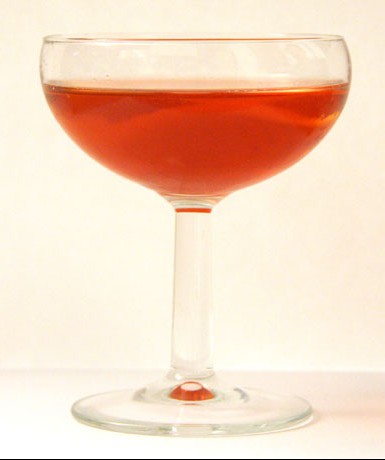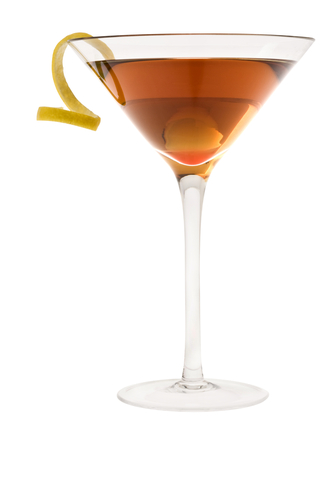Drink of the Week: The Jupiter
 Sometimes the hardest thing about writing and preparing for DOTW is simply picking out the drink. I can spend, it seems, many hours online trolling for a cocktail that won’t take hours to make and where I won’t have to spend an arm and a leg buying several expensive ingredients I barely have room for at stately DOTW Manor.
Sometimes the hardest thing about writing and preparing for DOTW is simply picking out the drink. I can spend, it seems, many hours online trolling for a cocktail that won’t take hours to make and where I won’t have to spend an arm and a leg buying several expensive ingredients I barely have room for at stately DOTW Manor.
So, I alway love it when some cool person suggests a possible mixed drink or cocktail (people I read keep telling me there’s a difference) for me to try. In fact, if anybody would like to come up with a suggestion for a drink that hasn’t been featured before in comments or e-mail, I promise to give it a fair hearing.
In this case, the cool person suggesting the drink was the highly esteemed Christopher Tafoya, Facebook friend, mutual real life friend with other real life friends, and cocktail enthusiast. Christopher provided an interesting find that’s forcing me to diverge from orthodoxy just a bit, while only forcing me to purchase one very interesting and odd new ingredient. It’s also got a name with just enough of a touch of science fiction to it to make it semi-appropriate for the week of Comic-Con. That’s where I’ll be by the time you read this, and also the reason this series will be taking a break next week. Anyhow, here’s this week’s cosmic selection.
The Jupiter
1 1/2 ounces dry gin
1/2-3/4 ounce dry vermouth
1 teaspoon fresh squeezed orange juice
1 teaspoon parfait amour
This one’s as easy to make as they come. Combine the ingredients in a cocktail shaker. Shake. Strain into a cocktail glass. Sip, preferably while listening to the music of the spheres or at least Richard or Johan Strauss.
****
Remember when I implied my take was a bit heretical? Well, credit for the revival of the Jupiter in recent years goes mainly to the revered Ted Haigh, author of Vintage Spirits and Forgotten Cocktails, who picked the drink out from a number of older tomes. He, however, declared that it was the one drink in his entire book requiring the most precision. Depart by even the difference between a measuring teaspoon and a dining teaspoon and, as far as Haigh is concerned, the drink is mostly done for.
Part of the reason for that is Parfait Amour. This somewhat obscure and not too easily found liqueur, extracted from exotic oranges and vanilla pods, is both very sweet and very purple. It also gives the Jupiter it’s slightly grey, otherworldly hue. I can’t disagree with Haigh that a little goes a long way, but I’d like just a little more, proportionally speaking.
So, when Mr. Tafoya let me know that a slightly different recipe existed — I’d looked in a number of places and had seen exactly the same recipe he first gave me — I had to give the alternative version a try. What a shock that it turned out to be, to my taste buds, quite a bit better. Basically, I found that a quarter of an ounce less vermouth made for what I found to be a brighter, more enjoyable beverage.
So, dear readers, I’m giving you a choice: 1/2 or 3/4 ounce of dry vermouth. Which drink would the evolved Dave Bowman choose?
See you in two weeks, star children.
You can follow us on Twitter and Facebook for content updates. Also, sign up for our email list for weekly updates and check us out on Google+ as well.
Posted in: Food & Drink, Lifestyle, Vices
Tags: 2001: A Space Odyssey, Beefeater Gin, Christopher Tafoya, cocktails, Drink of the Week, dry vermouth, Happy Hour, Marie Brizard Parfait Amour, Martini & Rossi, Noilly-Pratt, Parfait Amour, rye whiskey, Ted Haigh, the Jupiter, the Negroni, Vintage Spirits and Forgotten Cocktails

 Can a drink be like an old friend? Should a drink be like an old friend? It’s way too late as I’m writing this to even begin answering those questions, but I can tell you I much prefer the older version of this prohibition era
Can a drink be like an old friend? Should a drink be like an old friend? It’s way too late as I’m writing this to even begin answering those questions, but I can tell you I much prefer the older version of this prohibition era  This probably isn’t the first time, but we’re doing things a bit bass ackward this week. That’s what happens when someone is nice enough to send something for free along with a recipe, and then that recipe turns out to be a very acceptable variation on a
This probably isn’t the first time, but we’re doing things a bit bass ackward this week. That’s what happens when someone is nice enough to send something for free along with a recipe, and then that recipe turns out to be a very acceptable variation on a  Now is the time at Drink of the Week when we discuss ingredients and their discontents. For starters, both the classic recipes with dry vermouth and rye and the one I received from Canadian Club contain a little known bittersweet liqueur called Amer Picon.
Now is the time at Drink of the Week when we discuss ingredients and their discontents. For starters, both the classic recipes with dry vermouth and rye and the one I received from Canadian Club contain a little known bittersweet liqueur called Amer Picon. We’re continuing with the
We’re continuing with the 








